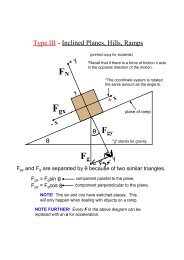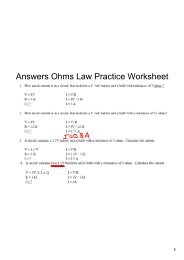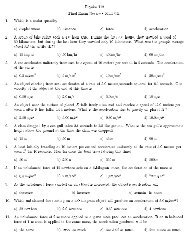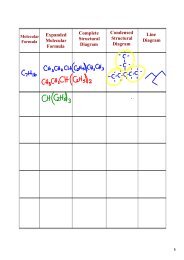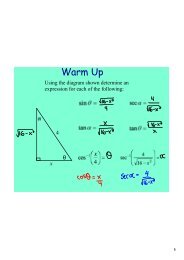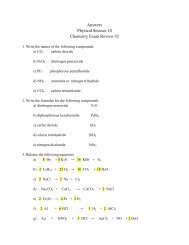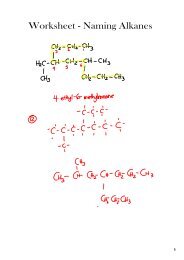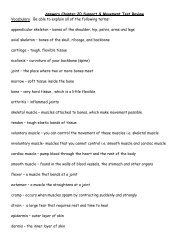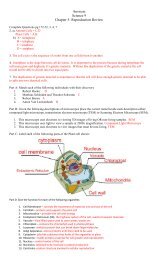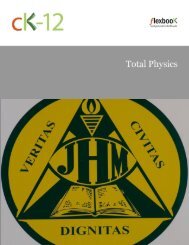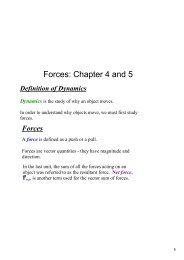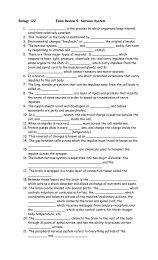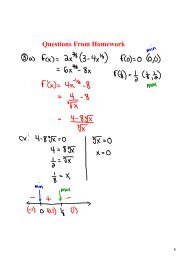Physics Study Guides.pdf - James M. Hill Memorial High School
Physics Study Guides.pdf - James M. Hill Memorial High School
Physics Study Guides.pdf - James M. Hill Memorial High School
You also want an ePaper? Increase the reach of your titles
YUMPU automatically turns print PDFs into web optimized ePapers that Google loves.
WavesBig Picture<strong>Study</strong> <strong>Guides</strong>Waves transfer energy between two points in space without transferring any actual matter. For example, when a rockis dropped into a pond, the waves that emanate from the point of impact are transferring the rock’s kinetic energyto the edge of the pond. All waves are the result of some sort of vibration. Sound waves result from the macroscopicvibrations of objects, and electromagnetic waves result from the vibrations of electrons in atoms. Similar to simpleharmonic motion, the motion of waves can be mathematically modeled by sine and cosine curves.Key TermsNote: Some of the terms from the Simple Harmonic Motion study guide are also used in the description of waves. Theexplanations for period, frequency, and amplitude can be found there.Mechanical Wave: Needs a medium to travel through.Transverse Wave: Energy is transferred by particlesvibrating perpendicular to the direction the wave istraveling.Longitudinal Wave: Energy is transferred by particlesvibrating in the same direction as the wave’s motion.Interference: When two waves of the same type meet,they combine to create a larger or smaller wave.Destructive Interference: When two waves meet, ifone is at the highest point in its vibration (crest)and another is at its lowest (trough), they canceleach other out so no wave appears at this point.Constructive Interference: If the waves meet whenthey are both at their crests, their amplitudes willadd together so that there appears to be a verylarge wave at that point.Beat Frequency: The difference in frequencies whenwaves with two different frequencies interfere.Standing Wave: A wave that stays in a constantposition. They are the result of interference betweentwo waves traveling in different directions.Node: Location of complete destructive interferencebetween the the incident (initial) wave and thereflected wave. The wave does not move at a node.Antinode: Location of complete constructive interference.The wave will have the greatest displacementat an antinode.Resonance: When an object is shaken or pushed at afrequency that matches its natural frequency.Doppler Effect: When there is an apparent change ina wave’s frequency due to the relative motion ofeither the source of the wave or the observer.<strong>Physics</strong>Disclaimer:Mechanical WavesMechanical waves travel through a substance calleda medium.• Examples include sound waves (travel through air),and seismic waves (travel through the ground).• Mechanical waves cannot transfer energy if there isno medium between the origin of the wave and itsdestination.• Speed of a wave depends on the medium.Two main types of mechanical waves are transversewaves and longitudinal waves.Waves on the surface of water are an exampleof transverse waves. The water molecules moveperpendicular to the surface of the water (up and down)to transfer the energy, while the wave itself movesalong the surface.Image Credit: CK-12 FoundationCC-BY-NC-SA 3.0• crest - highest point of the wave• trough - lowest point of the wave• amplitude - distance between the equilibriumposition and the crest (or trough)• wavelength - distance between identical positions ontwo successive wavesThis guide was created by Christopher Addiego and Catherine Wu. To learnmore about the student authors, visit http://www.ck12.org/about/about-us/team/interns.Have you ever seen people in a stadium do thewave? The wave travels around the stadium,but the people do not.We can visualize a longitudinal wave by laying a spring(such as a Slinky) on the ground, stretching it out, thenpushing one end of the spring. The compression travelsup the spring.Sound waves are longitudinal mechanical wavesthat propagate through air. Sound waves are causedby vibrations in objects and exist as differences inpressure. They can be thought of as vibrations in themedium the sound waves are traveling through. Thevibrations in air cause our ear drums to vibrate, whichour brain interprets as sound. The speed at which soundwaves travel depends on the medium which they’repassing through. Sound travels fastest through solids,and slowest through gases, but it varies with eachsubstance. Below is a diagram of a sound wave, wherethe dots represent air molecules.Page 1 of 2v1.11.1.2011this study guide was not created to replaceyour textbook and is for classroom or individual use only.




